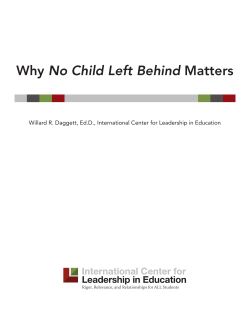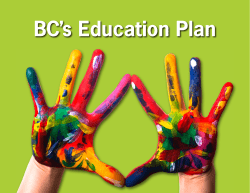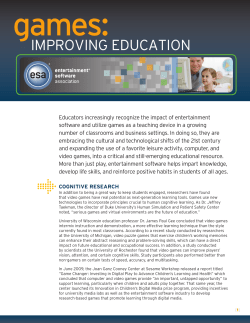
Observing children Gathering and analysing information to inform curriculum decision making
NQS PLP e-Newsletter No.39 2012 Observing children Gathering and analysing information to inform curriculum decision making Setting the scene This e-Newsletter is the first of two that focus on assessment in early childhood settings. This e-Newsletter focuses on formative assessments—the process of observing children in everyday experiences, analysing those observations and recording the information. Formative assessments include jottings, photos and notes as well as more formal assessments of children’s experiences and learning. The next e-Newsletter will focus on summative assessments—bringing together a range of observations and analyses to create a summary of children’s learning. Both forms of assessment contribute essential insights into what children are gaining from their experiences in early childhood settings and help to ensure that the curriculum contributes to their learning in each of the Early Years Learning Framework (EYLF) Outcome areas. The educational theorist John Dewey said, ‘Observation alone is not enough. We have to understand the significance of what we see, hear, and touch. This significance consists of the consequences that will result when what is seen is acted upon’ (1938, p. 68). Effective assessment requires both awareness of what children are doing and insights about meaning. Effective assessment goes beyond educators seeing and hearing to include deep thinking and making sense of what they observe, then using what they understand to enrich and extend children’s learning. The challenges are to ensure that observations and assessments: are an effective use of time increase understanding of each child’s learning inform future curriculum decisions enable evidence of children’s learning to be shared with families. Using these criteria can help you consider what is worth spending time on and what types of assessments will work best in your setting. The EYLF defines assessment as ‘… the process of gathering and analysing information as evidence of what children know, can do and understand’ (DEEWR, p. 17). It recommends that educators use a variety of strategies to collect, document, organise and interpret that information. Rather like constructing a complex puzzle, educators gather all the small pieces, look carefully at their characteristics and put them together to construct a complete picture. This first e-Newsletter is about gathering all of the pieces and noticing important factors that will contribute to later understandings. 1 What does the NQS say? Element 1.1. 2 of the National Quality Standard (NQS) (ACECQA, 2011) requires that ‘Each child’s current knowledge, ideas, culture, abilities and interests are the foundation of the program’ (p. 28). Element 1.2.1 states that ‘Each child’s learning and development is assessed as part of an ongoing cycle of planning, documenting and evaluation’ (p. 32). Educators must get to know individual children as well as the group. Recording information about each child contributes to knowing them well. There are many myths about the number of observations required for each child each week and the types of assessment that are acceptable (for example, that learning stories are the only acceptable form of assessment). The NQS does not specify the number or type of assessments that are required and recommends variety: Educators use a variety of strategies to collect, document, organise, synthesise and interpret the information that they gather to assess children’s learning. They search for appropriate ways to collect rich and meaningful information that depicts children’s learning in context, describes their progress and identifies their strengths, skills and understandings (EYLF, DEEWR, p. 17). Learning about each child’s current knowledge, ideas, culture, abilities and interests The following are some examples of assessments that can help build a rich picture of each child. Seeking information from families. At enrolment families can complete a ‘getting-toknow-you’ form. Brief, general questions about children’s interests and friendships, for example, encourage families to share their unique knowledge. Using the information on the form, not simply filing it away, is crucial. Keeping ongoing notes as families share their thoughts and observations about their child keeps the conversation alive. Showing families that you value their contributions will encourage the ongoing sharing of insights. After enrolment, ongoing conversations are a friendlier and more useful way to communicate than filling in forms. Using jottings and notes of incidental events. Observations do not always need to be neatly typed and edited or only written about major milestones. Noting children’s questions, brief transcripts of their conversations, or quick jottings of a play situation can provide valuable insights into children’s questions, ideas and knowledge. Waiting for momentous events means missing out on meaningful learning that occurs in everyday experiences. Educators need to be alert to learning at any time, including in routines, not just in planned learning activities. This is especially important with infants and toddlers, who learn so much and demonstrate learning in brief encounters. Quick jottings are perfect for capturing these events. Analysis can happen later. Taking photos of children’s experiences. Photography has become very popular in early learning settings. At times it can seem as though capturing the photo is more important than noticing the learning that is happening! Constant photographing can be very unsettling and interrupt the flow of play and learning experiences. However, judicious use of photos with analysis can help to capture children’s learning very effectively. Educators need to think carefully about what is worth capturing in a photo and how the image can contribute to understandings about children’s learning. Photos alone do not make useful assessments. They need to be analysed, interpreted and annotated to provide the background and information about the learning. Often a series of photos showing a developing skill or idea or a project is more useful evidence of learning than a single photo. For example, educators who take photos of a group of children playing with blocks over several weeks can analyse them to see how children’s block-building skills and ideas are developing. Collecting samples or copies of children’s work—writing, drawing, painting or photos of sculptures or constructions. These samples also need annotations about the context and the important factors in the experience, such as how the work was completed, challenges the children experienced, how they negotiated or solved problems and how the work demonstrates their interests and knowledge. Observing children’s social play and keeping notes on friendships, roles and challenges. These might be more formal observations, such as anecdotes, running records or learning stories. In-depth records help to focus on particular aspects of a child’s experience. They can also be useful if there are concerns about a child’s development and learning or when they are experiencing challenges. 2 Practice example Following are two samples of one child’s (Greta, aged five years) work completed a few weeks apart. All assessment strategies require educators to be keen watchers, expert listeners and wise thinkers. While educators assess as part of their everyday interactions with children, developing and refining observation skills is an essential focus for ongoing professional learning. Taking time to pause and really listen to what children are saying, to encourage extended conversations and to stay completely focused in a conversation with children takes practice and commitment. It is easy to be caught up and distracted by the busyness of the day with young children. Recognising the importance of assessments is a reminder to slow down and really look and listen. Equally important is taking time to watch closely—to avoid assuming that a first glance gives the whole picture. Watching children carefully over an extended period of time reveals patterns of play, friendships that you might not have been aware of and sources of children’s frustration or negative behaviour. Careful, ongoing attention allows you to notice what might otherwise be missed and to see children in their rich complexity. The alternative is a collection of simplistic observations that all look the same and could be about any child. The first example was a starting-school assessment given to all children. The second was part of a drawing, painting and collage project that took place over several days as part of a group project about communities. Most children completed the first task in a similar way and there was little variation in the final product. The teacher was able to make some general assumptions about the children’s ability to write their own name, colour between the lines and follow a simple number sequence. Greta did not talk much about this work, although she was puzzled about why the rabbit was holding a star. The second sample shows evidence of skilled drawing and attention to detail, with individualised interpretations of a house, rainbow, garden and pets. This work provides a deeper insight into Greta’s understandings and thinking. She spoke with many people about this drawing and the different techniques she used to represent her ideas. Both samples provide insights into Greta’s learning and links to the EYLF Learning Outcomes. The second sample tells us much more however, particularly because Greta talked about her work, which contributes to our understandings of her learning. We do not do justice to children’s learning if we only use simplistic standardised tasks. Knowing the Learning Outcomes well allows us to see evidence of children’s learning—in their everyday play situations, routines and in the work that they complete—and to gain deep understandings of each child. Standardised assessments can restrict us to general and oversimplified notions that limit what we know about each child. Critical thinking is essential to making sense of observations. The more knowledgeable educators are about theories of learning and development, the more useful observations will be. As lifelong learners, educators need to commit to continuing to develop their knowledge about theories and asking critically reflective questions about what they observe. 3 The keys to good observation What next? A few key questions to consider in thinking about the connection between observation and assessment include: Educators in each early childhood setting have to determine what to observe, how much to record and what best suits their context. Although the NQS does not specify how each setting needs to show evidence, it does require that educators show that they have deep knowledge of each child and that this knowledge is used to plan the educational program. Educators are also required to make information about each child available for families and to show children’s learning in each of the EYLF Learning Outcome areas. This newsletter has provided some ideas for gathering a range of assessment items that can contribute to these requirements. The next step is to combine all the information gained through many assessments into summaries of the child’s learning. The next newsletter will look more closely at summative assessment. What should be the focus of attention? Begin by noticing everything and use the EYLF Learning Outcomes as a guide to thinking about what you see. The more you work with the Learning Outcomes, the easier it is to see evidence of children’s learning in just about everything they do. The Outcomes can also remind us to look for learning we might not normally pay attention to. What is worth recording and how? Use the Learning Outcomes as a guide to what is most important to record. Scribbled notes, jottings and quick annotations on a photo do not always need to be re-written neatly or typed and can contribute to reflecting on children’s learning. You can decide later about what to spend time recording more neatly and formally. How can observations be organised to be meaningful and contribute to the requirements of the NQS? There are many possibilities for pulling together assessments. It is important to find strategies that capture critical information and that are efficient uses of time. The NQS does not contain specific requirements about children’s records, and there is no requirement for a polished and professionally presented portfolio. Keep in mind that the purpose of assessment is to inform curriculum decisions and enrich communication with families. Sandra Cheeseman Early childhood lecturer and writer References Australian Children’s Education and Care Quality Authority (ACECQA) (2011). Guide to the National Quality Standard. Sydney: ACECQA. Australian Government Department of Education, Employment and Workplace Relations (DEEWR) (2009). Belonging, being and becoming: The Early Years Learning Framework for Australia. Retrieved 15 June 2012, from http://www.deewr.gov. au/EarlyChildhood/Policy_Agenda/Quality/Documents/A09-057%20EYLF%20 Framework%20Report%20WEB.pdf. Dewey, J. (1938). Experience and education. New York: Macmillan Publishing Company. Acknowledgment Thanks to Greta Baggaley for sharing her masterpieces. Biography Sandra Cheeseman is a lecturer in early childhood at the Institute of Early Childhood, Macquarie University. She was a member of the writing team that developed the EYLF on behalf of the Australian Government. Coordinating Editor Anne Stonehouse lives in Melbourne and is a consultant in early childhood. She was a member of the consortium that developed the national Early Years Learning Framework. Brought to you by The NQS Professional Learning Program is funded by the Australian Government Department of Education, Employmentand Workplace Relations. 4
© Copyright 2025





















